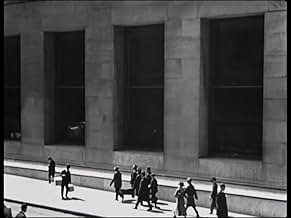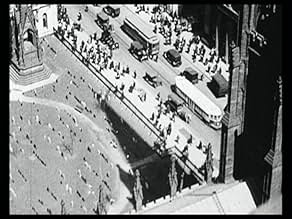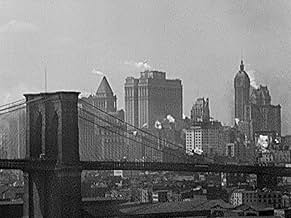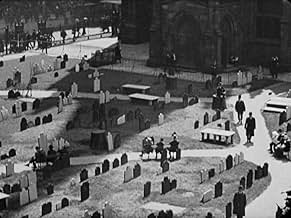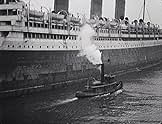CALIFICACIÓN DE IMDb
6.6/10
1.7 k
TU CALIFICACIÓN
Agrega una trama en tu idiomaThis groundbreaking silent documentary captures the beauty and majesty of the New York City in its streets, skyscrapers, bridges, rail yards and harbors.This groundbreaking silent documentary captures the beauty and majesty of the New York City in its streets, skyscrapers, bridges, rail yards and harbors.This groundbreaking silent documentary captures the beauty and majesty of the New York City in its streets, skyscrapers, bridges, rail yards and harbors.
- Dirección
- Guionista
- Premios
- 1 premio ganado en total
Opiniones destacadas
MANHATTA is an unusual short film. It's like the merging of a travelogue with a poem. So, as the camera moves artistically about the city of New York, the scenes are punctuated with intertitle cards that have poetic verse on them that make it all seem grand and majestic.
While much of this won't appeal to most viewers, the film is still worth seeing for two important reasons. First, the short is a wonderful historical record of the city. In other films of the era, New York is incidental, in a way. You might see bits and pieces of the city, but the city is not the star. Here, however, you see so much of the town that you wouldn't see otherwise--and much of it is gone today. Second, the film is very artistic in its cinematography--with wonderful aerial shots as well as nicely frames shots of the Brooklyn Bridge and the like.
Perhaps not exciting, but a rather important document. And, despite the original negatives being missing and only one print in existence until it was restored, the print looks great!
While much of this won't appeal to most viewers, the film is still worth seeing for two important reasons. First, the short is a wonderful historical record of the city. In other films of the era, New York is incidental, in a way. You might see bits and pieces of the city, but the city is not the star. Here, however, you see so much of the town that you wouldn't see otherwise--and much of it is gone today. Second, the film is very artistic in its cinematography--with wonderful aerial shots as well as nicely frames shots of the Brooklyn Bridge and the like.
Perhaps not exciting, but a rather important document. And, despite the original negatives being missing and only one print in existence until it was restored, the print looks great!
Preface: Due to the nature of such a short film, any valid review will contain some evidence of a "spoiler." This review is no exception.
Paul Strand's "Manhatta" is more than just the simple, pioneering piece in early cinema. "Manhatta" is a representation of New York City through the eyes of a still photographer. Strand uses the format of motion picture to create a sense of life. Similar to his New York still photography, each moving image frames city life, angles, and other objects with semi-avant-garde detail. Strand's own "mentor," Alfred Stieglitz, greatly appreciated the new form of city photography, publishing it in "Camera Work" and in his gallery 291.
In the movie, the blowing smoke, walking people, moving ships, and other objects in motion are what separate the motion picture from a photo album. Instead of portraying New York as an iconic, prosperous city, Strand has been able to portray New York City as an organism that contains a immigrant working class.
In my opinion, "Manhatta" commands the respect of many early motion pictures, influencing many great, more popular films.
Paul Strand's "Manhatta" is more than just the simple, pioneering piece in early cinema. "Manhatta" is a representation of New York City through the eyes of a still photographer. Strand uses the format of motion picture to create a sense of life. Similar to his New York still photography, each moving image frames city life, angles, and other objects with semi-avant-garde detail. Strand's own "mentor," Alfred Stieglitz, greatly appreciated the new form of city photography, publishing it in "Camera Work" and in his gallery 291.
In the movie, the blowing smoke, walking people, moving ships, and other objects in motion are what separate the motion picture from a photo album. Instead of portraying New York as an iconic, prosperous city, Strand has been able to portray New York City as an organism that contains a immigrant working class.
In my opinion, "Manhatta" commands the respect of many early motion pictures, influencing many great, more popular films.
Here's the beginning of the city symphony film, which would include "Berlin: Symphony of a City" (1927) and "The Man with a Movie Camera" (1929). Although "Manhatta" doesn't contain the rapid rhythmic montage of some of the later city symphonies, it does have a sort of slower, poetic rhythm to it. It's discernible from a travelogue in that it has something to say about its city, other than it's a nice place to visit. The steady progression of images interloped with poetic intertitles taken from Walt Whitman produce the rhythm.
From the still photographer Paul Strand and the painter and still photographer Charles Sheeler, their view of Manhattan is, of course, modern. The shots are of skyscrapers and the inter-workings of the city. One is Strand's 1915 still photograph "Wall Street" come to motion. The composition, camera placement and observation of light and shadow are striking throughout the short film, and they are reflective of the work by the filmmakers in other media. Sheeler and Strand had already transplanted modern, abstract and formal ideas from painting into still photography and with "Manhatta" they similarly redirected film.
From the still photographer Paul Strand and the painter and still photographer Charles Sheeler, their view of Manhattan is, of course, modern. The shots are of skyscrapers and the inter-workings of the city. One is Strand's 1915 still photograph "Wall Street" come to motion. The composition, camera placement and observation of light and shadow are striking throughout the short film, and they are reflective of the work by the filmmakers in other media. Sheeler and Strand had already transplanted modern, abstract and formal ideas from painting into still photography and with "Manhatta" they similarly redirected film.
This short film by Sheeler and Strand is the father of American avant-garde cinema.
It contains beautiful shots of Manhattan shown intertwined with excerpts of a Walt Whitman poem. All of the shots are thought out, and very photographic in nature. But that is expected with Paul Strand behind the camera.
This film is probably the first American avant-garde film, and if it isn't, it is definitely the first influential avant-garde film. A guideline for future American avant-garde filmmakers to follow.
A true visual treat, even for today's standard.
It contains beautiful shots of Manhattan shown intertwined with excerpts of a Walt Whitman poem. All of the shots are thought out, and very photographic in nature. But that is expected with Paul Strand behind the camera.
This film is probably the first American avant-garde film, and if it isn't, it is definitely the first influential avant-garde film. A guideline for future American avant-garde filmmakers to follow.
A true visual treat, even for today's standard.
This experimental movie of Paul Strand about Manhattan is extremely important to the future generations of directors. Paul Strand is like a bird in Manhattan, showing the daily life and the most characteristic points of it. Manhattan is shown in a Bird's eye shot(I think that it's the name in English, kind like the public was God himself. I never went to Manhattan, but in 10 minutes I visited, understood and felt Manhattan. It is amazing how in such a short time, he can illustrate, in a interesting and original way, this mediatic place. Paul Strand is like a magician that takes photos of Manhattan and give life to them. A great short that definitely is a mark on cinema's experimental history.
¿Sabías que…?
- TriviaThe poet whose works are quoted during the film is Walt Whitman.
- Citas
Title Card - Walt Whitman: "City of the world - for all races are here, City of tall facades of marble and iron, Proud and passionate city."
- Versiones alternativasThis film was published in Italy on an DVD anthology entitled "Avanguardia: Cinema sperimentale degli anni '20 e '30", distributed by DNA Srl. The film has been re-edited with the contribution of the film history scholar Riccardo Cusin . This version is also available in streaming on some platforms.
- ConexionesFeatured in The Secret Life of Sergei Eisenstein (1987)
Selecciones populares
Inicia sesión para calificar y agrega a la lista de videos para obtener recomendaciones personalizadas
Detalles
- Tiempo de ejecución
- 11min
- Color
- Mezcla de sonido
- Relación de aspecto
- 1.33 : 1
Contribuir a esta página
Sugiere una edición o agrega el contenido que falta

